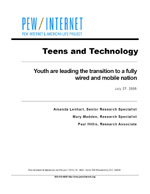 Zusammenfassungen
Zusammenfassungen
Von Beat Döbeli Honegger, erfasst im Biblionetz am 23.09.2005
 Today’s American teens live in a world enveloped by communications technologies; the internet and cell phones have become a central force that fuels the rhythm of daily life.
Today’s American teens live in a world enveloped by communications technologies; the internet and cell phones have become a central force that fuels the rhythm of daily life. The number of teenagers using the internet has grown 24% in the past four years and 87% of those between the ages of 12 and 17 are online. Compared to four years ago, teens’ use of the internet has intensified and broadened as they log on more often and do more things when they are online.
Among other things, there has been significant growth over the past four years in the number of teens who play games on the internet, get news, shop online, and get health information.
Not only has the number of users increased, but also the variety of technologies that teens use to support their communication, research, and entertainment desires has grown.
These technologies enable a variety of methods and channels by which youth can communicate with one another as well as with their parents and other authorities. Email, once the cutting edge "killer app," is losing its privileged place among many teens as they express preferences for instant messaging (IM) and text messaging as ways to connect with their friends.
In focus groups, teens described their new environment. To them, email is increasingly seen as a tool for communicating with "adults" such as teachers, institutions like schools, and as a way to convey lengthy and detailed information to large groups. Meanwhile, IM is used for everyday conversations with multiple friends that range from casual to more serious and private exchanges.
It is also used as a place of personal expression. Through buddy icons or other customization of the look and feel of IM communications, teens can express and differentiate themselves. Other instant messaging tools allow for the posting of personal profiles, or even "away" messages, durable signals posted when a user is away from the computer but wishes to remain connected to their IM network.
 Bemerkungen zu diesem Buch
Bemerkungen zu diesem Buch
 Leider ist die ursprünglich im Biblionetz erfasste URL eines Volltextes seit mehr als sechs Monaten nicht mehr gültig (Fehlermeldung 404) und wurde deshalb gelöscht. Es ist mir nicht bekannt, ob das Dokument unter einer anderen Adresse noch frei auf dem Internet verfügbar ist.
Leider ist die ursprünglich im Biblionetz erfasste URL eines Volltextes seit mehr als sechs Monaten nicht mehr gültig (Fehlermeldung 404) und wurde deshalb gelöscht. Es ist mir nicht bekannt, ob das Dokument unter einer anderen Adresse noch frei auf dem Internet verfügbar ist. Dieses Buch erwähnt ...
Dieses Buch erwähnt ...
 Dieses Buch erwähnt vermutlich nicht ...
Dieses Buch erwähnt vermutlich nicht ... 
 Nicht erwähnte Begriffe | Ein Notebook pro StudentIn (ENpS), Eltern, Handheld / PDA in school, Notebooks an Schulen, Schule |
 Tagcloud
Tagcloud
 Zitationsgraph
Zitationsgraph
 Zitationsgraph (Beta-Test mit vis.js)
Zitationsgraph (Beta-Test mit vis.js)
 2 Erwähnungen
2 Erwähnungen 
- ICT-Kompass - Bildung braucht ICT (Stephan Brülhart, Beat Döbeli Honegger, Stanley Schwab) (2005)



- Digital Culture - Immigrants and Tourists Responding to the Natives’ Drumbeat (Cheri A. Toledo) (2007)


 Co-zitierte Bücher
Co-zitierte Bücher
 Volltext dieses Dokuments
Volltext dieses Dokuments
 Externe Links
Externe Links
 Teens and Technology: Website of this report ( Teens and Technology: Website of this report (  : :  Link unterbrochen? Letzte Überprüfung: 2020-11-28 Letzte erfolgreiche Überprüfung: 2014-01-28) Link unterbrochen? Letzte Überprüfung: 2020-11-28 Letzte erfolgreiche Überprüfung: 2014-01-28) |
 Anderswo suchen
Anderswo suchen 
 Beat und dieses Buch
Beat und dieses Buch
Beat war Co-Leiter des ICT-Kompetenzzentrums TOP während er dieses Buch ins Biblionetz aufgenommen hat. Die bisher letzte Bearbeitung erfolgte während seiner Zeit am Institut für Medien und Schule. Beat besitzt kein physisches, aber ein digitales Exemplar. (das er aber aus Urheberrechtsgründen nicht einfach weitergeben darf). Es gibt bisher nur wenige Objekte im Biblionetz, die dieses Werk zitieren.












 Computer
Computer E-Mail
E-Mail Internet
Internet Kinder
Kinder location sharing
location sharing Notebook
Notebook

 , 364 kByte)
, 364 kByte)  Biblionetz-History
Biblionetz-History